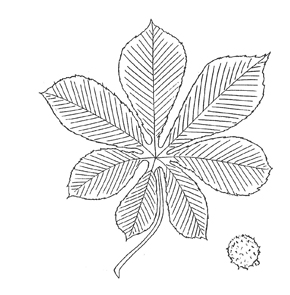Aesculus hippocastanum (es’-ku-lus hip-o-kas-ta’-num)
Family: Sapindaceae, Soapberry
Key Steps
- 1a – Opposite leaf arrangement on stem — go to 2
- 2b – Leaf compound — go to 14
Description
 Leaf: Usually 7 (rarely 5 or 9) leaflets, each 4-10 inches long, wedge-shaped, long pointed base, short pointed tip, doubly toothed margin. No petiolules (leaflet stalk).
Leaf: Usually 7 (rarely 5 or 9) leaflets, each 4-10 inches long, wedge-shaped, long pointed base, short pointed tip, doubly toothed margin. No petiolules (leaflet stalk).
Buds: Terminal bud is sticky, dark brown, large (½ inch or longer) and oval. Lateral buds are smaller and have 4 or more pairs of scales.
Leaf Scar: Large, shield-shaped or triangular. 5-7 bundle scars that are in pairs of 2 or 3.
Stem: Stout (1/4 inch thick or more). Large lenticels. No odor when crushed.
Pith: Large, continuous, pale. May be six-sided.
Bark: Dark gray-brown. Exfoliating with age.
Flowers: Large showy, upright, white terminal panicle.
Fruit: Prickly, large ball containing 1-3 large shiny brown nuts. Ball cracks into 3 segments. Nuts are inedible and narcotic.
Habit: Medium size, dense, shade tree. Round canopy. 20-40 feet tall.
Culture: Moderate moisture requirements. Needs lots of room to spread. Avoid highly alkaline situations.
Note: Seeds, young stems and leaves of horsechestnut may be toxic to livestock.
Resources




